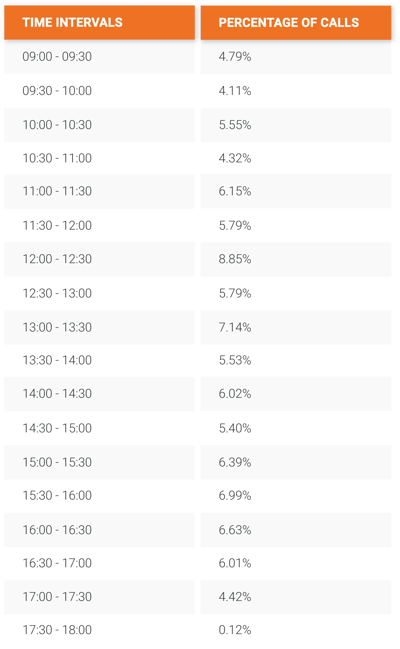
The Secret to Call Center Staffing
Call center managers have plenty of things to worry about: dealing with the toughest customers, training new call center staffing members on company procedures, supervising employees, and so much more. But for many, one of the biggest worries is the fear of under or overstaffing the call center.
While scheduling too few employees will lead to long wait times and disgruntled customers, tipping the scale too far in the other direction could lead to ballooning expenses and disgruntled upper management. It’s a tricky balance to strike, especially if you weren’t given a staffing formula or program to help.
Fortunately, there are plenty of established ways to calculate staffing needs at your call center. Here’s a simple breakdown of how to determine how many call center staff members you need.
CHOOSE YOUR CUSTOMER SERVICE GOALS
No matter how many employees you hire, it’s impossible to guarantee that your call center will be able to answer 100% of calls within a few seconds. Instead, companies typically aim to answer the majority of calls within a given time frame, such as 80% of calls within 20 seconds or 90% of calls within 10 seconds.
Before you can determine how many staff you need, you will need to choose the customer service level you are aiming for. If you’re not sure what your goal should be, you can choose one of the example goals above to use in your calculations. The more calls you want to answer within your time frame, the more staff you will need to hire.
GATHER YOUR DATA
1. FIND OUT HOW MANY CALLS ARE COMING INTO YOUR BUSINESS.
Most established call centers today collect data on how many calls come in every hour (or better yet, every half hour). You may be able to get accurate figures from your automated call distribution (ACD) system, call-logging system, or another system your company uses.
If you do not have access to these numbers, you can ask staff to manually log the number and time of calls as they come in. Then you can use a call-arrival pattern such as the one below (which shows the average percentage of calls per half hour for a typical call center open from 9 am to 6 pm) to estimate how many calls come in at each half-hour interval.

2. DETERMINE YOUR AVERAGE HANDLING TIME.
The average handling time (AHT) is the amount of time an average employee spends on a call. This includes both the call duration and wrap-up time.
Typically, you can get average call duration and wrap-up time figures from your ACD system, which you can add together to get the AHT. If you don’t have access to this information, you can try manually timing a day’s worth of customer-advisor interactions, including hold time, talk time, and wrap-up time. To get the AHT, you will need to add up all the times you recorded together and divide by the total number of calls you timed.
Companies in different sectors can have vastly different call center AHTs. For example, a retail company may have an AHT of 300 seconds while a telecommunications company has an AHT of 500 seconds.
3. FIGURE OUT YOUR SHRINKAGE
The other productivity factor you need to consider is shrinkage, which is the amount of paid time when an employee is not available to do productive work. Your call center employees can’t spend 100% of their workday on the phone, after all! Shrinkage can happen for any number of reasons, from team meetings and coaching to employees taking sick leave or paid breaks.
To take time spent off the phone into account, you will need to choose a shrinkage number to use in your staffing calculations. According to a survey of 111 call center employees by Knowlagent, the average call center shrinkage time is 24%, although shrinkage times up to 35% or higher are not uncommon.
THE CALL CENTER STAFFING CALCULATOR
Once you have all of the numbers we discussed above — customer service level goals, average handling time, incoming calls per hour or half-hour, and shrinkage — you can enter them into an Erlang calculator such as this one. Erlang calculators use a mathematical equation to calculate the number of call center agents you need based on the information you provide.
Be sure to check that the numbers you put into the calculator are in the same units that the calculator uses. For example, many calculators require you to input the average handling time in seconds rather than minutes.
As a reminder, you should always use an Erlang calculator that takes into account the fact that call volumes vary from hour to hour. If you only consider the number of calls throughout the day as a whole, you are likely to end up with an understaffed call center and lengthy customer wait times during busy hours. Calculating the number of staff needed at different times takes longer, but it’s worth the effort to ensure you reach your customer service goals.
Now you know how many people you need to staff your call center! Once you have all the right numbers and statistics, staffing your call center can be fairly stress-free.
NEED MORE CALL CENTER STAFF MEMBERS?
LG Resources provides high-quality call center staffing solutions for employers throughout Utah, Kansas, Missouri, and Pennsylvania. You can count on us to find customer service staff with the skills and temperament you need, on budget and within your time frame. Reach out to us today to request an employee.
From the Blog

Measuring the ROI of Temporary Staffing
So your current staff can’t quite meet your business needs. Maybe demand has increased, or maybe you’ve lost some employees recently. You’re wondering whether it makes sense to hire...

How Temporary Staffing Can Help With Seasonal Efficiency
Dealing with fluctuating demand is a logistical challenge for any business, even when you know it’s coming. When a new season brings short-term production increases or limited-time...

Boosting Productivity with Temporary Staffing Solutions
No matter what’s happening in the economy, your business is looking to boost its productivity. There’s a good chance you’re adjusting your workflow organization system, trying to...
